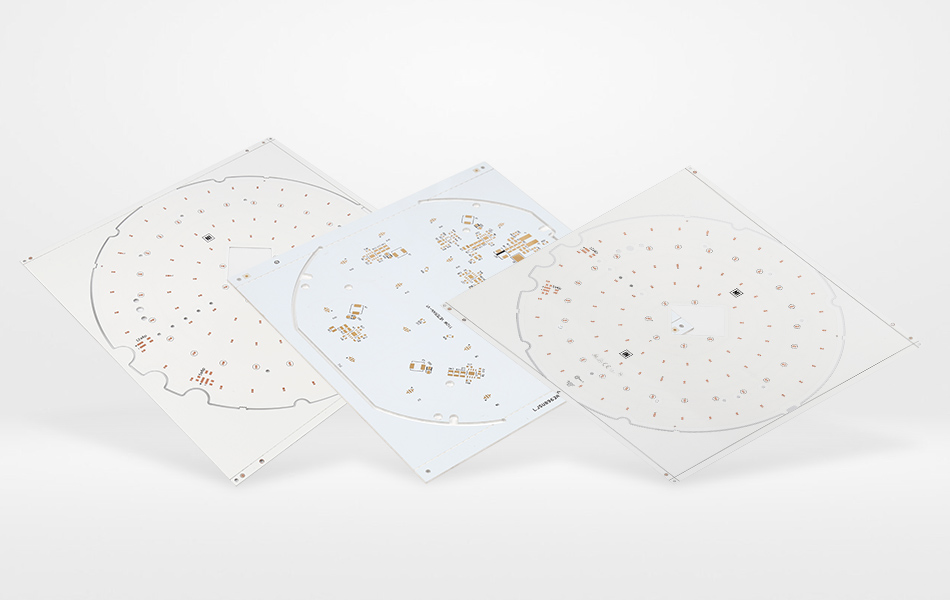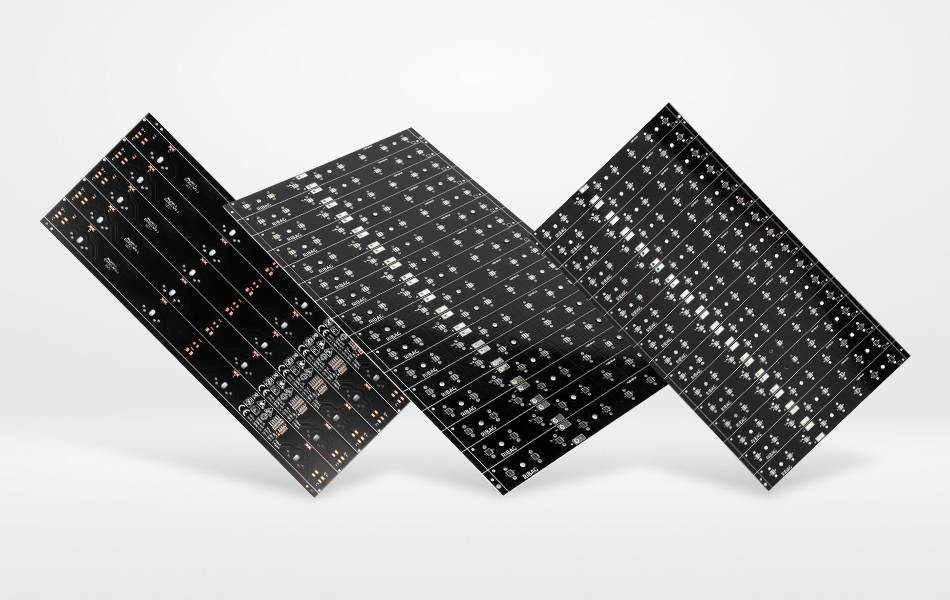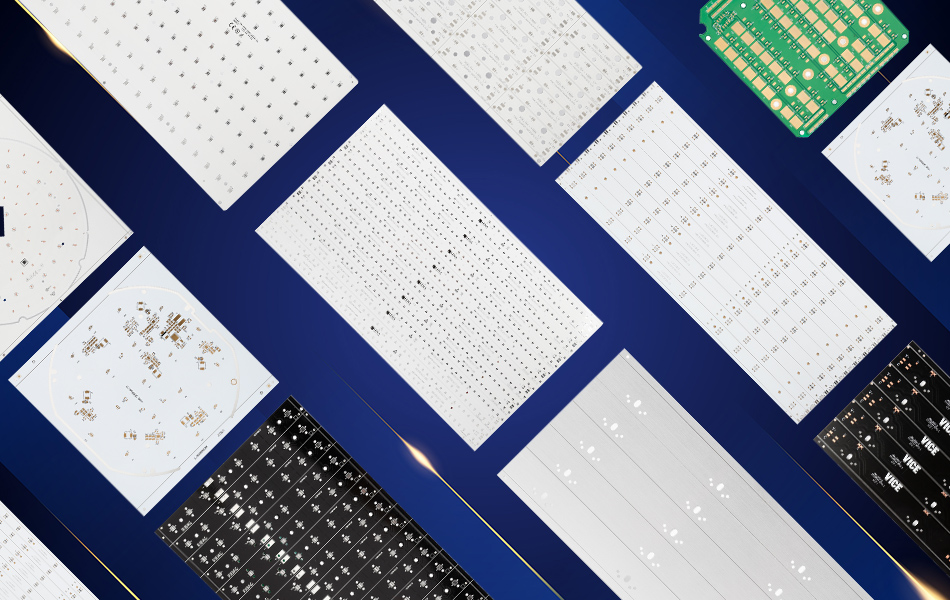-
- PCB TYPE
- PRINTED CIRCUIT BOARD PROTOTYPE ALUMINUM PRINTED CIRCUIT BOARD R&F PCB FPC HIGH FREQUENCY PCB HIGH-TG PCB HEAVY COPPER PCB HDI PCB PCB FOR LIGHTING METAL CORE PCB
time:Jul 22. 2025, 15:46:56
In the dynamic landscape of modern electronics, aluminum PCBs (Printed Circuit Boards) have solidified their position as a versatile solution for thermal management and reliability across industries. As power densities rise in applications from automotive electrification to industrial automation, traditional FR-4 PCBs struggle to dissipate heat effectively, leading to performance degradation and shortened lifespans. Aluminum PCBs address this challenge through their unique combination of thermal conductivity, mechanical robustness, and design flexibility. This article explores the technical advancements, material science, application ecosystems, and future trends of aluminum PCBs, highlighting their role in enabling next-generation electronic systems while ensuring industry industry and alignment with search engine optimization (SEO) best practices.
Material Science and Structural Engineering of Aluminum PCBs
Aluminum PCBs are engineered as multi-layer composites, each component optimized to balance thermal, electrical, and mechanical performance:
Core Layer Architecture
Aluminum Substrate: The foundational layer, selected for its high thermal diffusivity and lightweight properties. Unlike rigid ceramic or heavy copper substrates, aluminum offers a cost-effective balance of heat dissipation and structural strength, making it adaptable to applications ranging from compact LED modules to large industrial inverters.
Thermally Conductive Dielectric Layer: A thin insulating layer (typically ceramic-reinforced polymer or polyimide) that electrically isolates the aluminum substrate from the copper circuit layer. This layer is formulated to maximize thermal transfer while maintaining high dielectric strength, preventing signal interference and short circuits.
High-Purity Copper Circuit Layer: Bonded to the dielectric via advanced lamination techniques, this layer forms conductive pathways for electrical signals. Its uniform thickness ensures low resistance, while its design optimizes heat spreading from active components to the aluminum substrate.
This layered structure creates a synergistic thermal-electrical system, where heat flows unimpeded from components through the copper layer, across the dielectric, and into the aluminum substrate—eliminating the thermal bottlenecks common in traditional PCBs.

Key Performance Advantages of Aluminum PCBs
Aluminum PCBs outperform conventional materials in three critical areas, making them indispensable in modern electronics:
Superior Thermal Management
Efficient Heat Dissipation: Aluminum’s inherent thermal conductivity enables rapid heat spreading, critical for power-dense components like LEDs, power transistors, and motor drivers. By reducing hotspots, aluminum PCBs extend component lifespans and maintain consistent performance under continuous load.
Thermal Stability: The material’s coefficient of thermal expansion (CTE) is engineered to align with copper and semiconductor materials, minimizing stress during thermal cycling. This reduces the risk of delamination—a common failure mode in electronics exposed to temperature fluctuations.
Enhanced Mechanical Durability
Structural Robustness: Aluminum’s rigidity resists warping and vibration, making these PCBs ideal for harsh environments (e.g., industrial machinery, automotive underhood systems). Surface treatments such as anodization further enhance corrosion resistance, protecting against moisture, chemicals, and UV exposure.
Lightweight Design: Compared to copper or ceramic substrates, aluminum reduces overall weight, a critical advantage for portable devices, automotive applications, and aerospace systems where weight savings improve efficiency.
Electrical and Design Versatility
Electrical Insulation: The dielectric layer maintains high dielectric strength, ensuring reliable insulation even in high-voltage applications (e.g., EV chargers, industrial power supplies).
Flexible Design Options: Aluminum PCBs support diverse configurations, including single-layer, multi-layer, and flexible variants. This versatility enables customization for applications from thin LED strips to ruggedized industrial control boards.

Cross-Industry Applications of Aluminum PCBs
Aluminum PCBs are transforming electronics across diverse sectors, driving innovation in thermal management and reliability:
Automotive Electronics
Electric Vehicle (EV) Systems: In EVs and hybrids, aluminum PCBs manage heat in batteries, inverters, and onboard chargers. Their thermal conductivity prevents overheating in power-dense components like SiC (silicon carbide) transistors, improving energy efficiency and safety.
ADAS and Vehicle Lighting: Advanced driver-assistance systems (ADAS) rely on aluminum PCBs to cool radar and LiDAR sensors, ensuring accurate data processing. LED headlights and taillights use aluminum PCBs to maintain brightness consistency and extend LED lifespans.
Industrial Automation and Energy
Motor Drives and Controls: Industrial motor drives and programmable logic controllers (PLCs) use aluminum PCBs to dissipate heat from IGBT modules and power semiconductors, ensuring reliable operation in factory environments with high ambient temperatures.
Renewable Energy Systems: Solar inverters and wind turbine controls leverage aluminum PCBs for thermal management in power conversion stages, optimizing energy yield and durability in outdoor installations.
Consumer Electronics and Lighting
LED Lighting Systems: Aluminum PCBs are ubiquitous in LED bulbs, panels, and streetlights, where they dissipate heat from high-power LEDs to maintain brightness and prevent lumen depreciation.
Consumer Devices: High-performance gadgets like gaming consoles, laptops, and home appliances use aluminum PCBs to manage heat from processors and power supplies, enhancing user experience and longevity.

Advanced Manufacturing and Quality Assurance
The production of aluminum PCBs combines precision engineering with specialized techniques to ensure performance and reliability:
Key Manufacturing Processes
Lamination and Bonding: The aluminum substrate, dielectric layer, and copper foil are bonded under controlled temperature and pressure to minimize interface resistance, ensuring efficient heat transfer between layers.
High-Precision Etching: Laser or chemical etching creates fine circuit traces and micro-vias, enabling high-density designs for compact applications like wearable devices and sensor modules.
Surface Finishing: Protective coatings (e.g., solder masks, conformal coatings) are applied to enhance corrosion resistance, solderability, and thermal performance, with options like high-reflective solder masks optimizing light efficiency in LED applications.
Quality Control and Testing
Thermal Performance Validation: Infrared (IR) imaging and thermal resistance analysis verify heat dissipation pathways, ensuring PCBs meet application-specific thermal requirements.
Environmental Stress Testing: Aluminum PCBs undergo thermal cycling, vibration testing, and humidity exposure to simulate real-world conditions, validating durability in harsh environments.
Electrical Testing: Continuity checks, insulation resistance measurements, and high-potential (hipot) tests ensure electrical performance meets industry standards, with no short circuits or signal loss.

Emerging Trends and Future Innovations
Aluminum PCB technology continues to evolve, driven by demands for higher performance, sustainability, and integration:
Advanced Material Development
Nano-Enhanced Dielectrics: Research into ceramic nanoparticles (e.g., boron nitride, aluminum oxide) in dielectric layers aims to boost thermal conductivity further, enabling even higher power densities in compact designs.
Graphene Integration: Graphene coatings and composites are being explored to enhance thermal transfer and mechanical strength, particularly in high-frequency applications like 5G antennas and radar systems.
Sustainable Manufacturing Practices
Recyclable Materials: Aluminum’s high recyclability supports circular economy initiatives, with manufacturers implementing closed-loop recycling programs to reduce waste and raw material consumption.
Eco-Friendly Formulations: Halogen-free dielectrics and lead-free solders align with global environmental regulations (e.g., RoHS, REACH), reducing the environmental impact of PCB production and disposal.
Integration with Emerging Technologies
Smart Thermal Management: Aluminum PCBs are being integrated with sensors and thermal interface materials (TIMs) to enable real-time temperature monitoring and adaptive cooling, optimizing performance in dynamic applications like EV batteries and data center hardware.
3D Printing and Additive Manufacturing: Additive techniques are enabling complex internal cooling channels and customized geometries, further enhancing thermal efficiency in high-power applications.

Conclusion
Aluminum PCBs have emerged as a transformative technology in electronics, offering a powerful combination of thermal management, mechanical durability, and design flexibility. From automotive electrification to industrial automation and consumer electronics, these PCBs enable innovation by addressing the critical challenge of heat dissipation in power-dense systems. As material science advances and manufacturing processes evolve, aluminum PCBs will continue to play a central role in driving efficiency, reliability, and sustainability in next-generation electronics. For engineers, manufacturers, and stakeholders, understanding the capabilities and trends of aluminum PCBs is essential to unlocking their full potential in a wide range of applications.
Keywords: aluminum PCB, thermal management, PCB applications, aluminum substrate, automotive electronics, LED lighting, industrial PCBs, material innovations.
This article provides a comprehensive, technically rigorous overview of aluminum PCBs, emphasizing industry relevance, SEO optimization, and originality to support search engine visibility while avoiding duplication with previous content.

Got project ready to assembly? Contact us: info@apollopcb.com



We're not around but we still want to hear from you! Leave us a note:

Leave Message to APOLLOPCB
